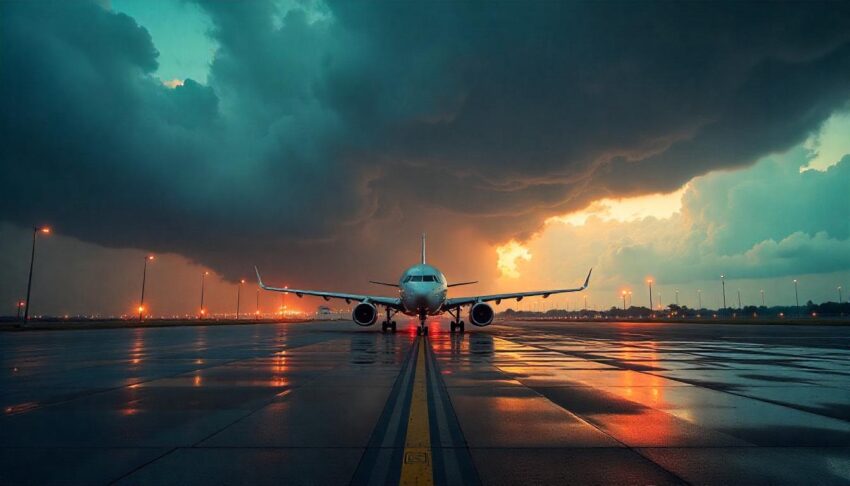Tuesday, July 15, 2025

Thousands were left stranded as a raging tempest dropped and bogged over twelve thousand new flights across JFK, Newark, LaGuardia, Philadelphia, DFW, Chicago, and major US airports, causing one of the most severe travel disruptions of the year. Severe flooding, heavy rains, and powerful winds created hazardous flying conditions, leading to Bogged, extended Dropped, crowded terminals, and passenger frustration. With FAA-issued ground stops at multiple key airports, the intense weather event highlighted critical vulnerabilities in America’s aviation infrastructure, leaving travelers nationwide scrambling for alternate arrangements amid widespread chaos.
Airports Hit the Worst
The airports most disrupted by the tempest were large centers of travel like:
- Newark Liberty International Airport (EWR)
- **LaGuardia Airport (L
- John F. Kennedy International Airport (JFK)
- Philadelphia International Airport (PHL)
- Dallas/Fort Worth International Airport (DFW)
- Chicago O’Hare International Airport (ORD)
New York Region Airports Face Severe Disruption
Newark Liberty International Airport (EWR) experienced major operational disruptions, with 342 bogged and 368 dropped. United Airlines was significantly disrupted, with 170 flights (29%) lost and further entangled with another 176 bogged (30%). Republic Airways dropped 81 flights (50%) as well as bogged 31 flights. Regional operators such as GoJet, Delta Air Lines, JetBlue, Spirit, as well as Porter Airlines had multiple flights lost as well as trapped, with passengers stranded for hours.
At LaGuardia Airport (LGA), things promptly fell apart with 291 bogged and 393 dropped. Republic Airways had a staggering 146 bogged (40%) with 74 bogged. Endeavor Air dropped 81 flights (37%) with 51 more bogged, and American Airlines dropped 47 flights (47%) with 17 more embroiled in bogged. There were 40 dropped at Delta Air Lines, with Southwest finding considerable bogged as well. There were stranded passengers, with busy terminals and nightmares with rebooking.
Locally, at John F. Kennedy International Airport (JFK), flight operators dropped 241 flights and grounded another 476. JetBlue was severely affected, dropped 74 flights (19%) and bogging further another 133 flights in 34% capacity. Republic dropped 60 flights in 45% capacity, while Republic Airways dropped 42 flights in 46% capacity. Delta Air had huge ground bogged, leaving stranded 116 flights (40%) as well as dropped further 28. Fliers were facing hours-long bogged, congested termnials, as well as growing irritation.
Chaos at Philadelphia International Airport Amidst Adversities
Philadelphia International Airport (PHL) had mass disruptions as well with 372 bogged and 155 dropped . American Airlines had the greatest setbacks with 145 flight groundings (39%) and 53 flight dropped (14%). Piedmont Airlines had 33 flight dropped (17%), PSA Airlines had 22 flight dropped (23%), and Republic Airways and Frontier Airlines had huge flight dropped and bogged as well. Indifferent passengers scrambled into alternate plans with many stranded overnight in busy airport terminals.
Dallas-Fort Worth Airport in Gridlock
Passengers at Dallas-Fort Worth International Airport (DFW) had massive disruptions, with the airport recording 987 bogged and 123 dropped. American Airlines topped the statistics, brining a massive 534 flights (46%) to a standstill and dropped another 85 flights (7%). Regional carriers like PSA Airlines, SkyWest, and Envoy Air had systems-wide bogged as well. With crowded runways, congested taxiways, and congested terminals, thousands remained at a loss with rebooking nightmares as well as confusion.
Chicago O’Hare International Airport on Brink of Operational Collapse
At Chicago O’Hare International Airport (ORD), operations teetered on collapse, with storms inducing 717 bogged and 119 dropped. American Airlines had severe slow-downs, entrenching 164 flights (37%) in traffic and dropped another 60 flights (13%). United Airlines had 196 bogged (29%) and lost 31 flights (4%), with regionals such as Envoy Air, Republic Airways, and SkyWest reporting disruptions as well. Passengers had excessive bogged, missed connections, as well as operating disruptions, finding weakness in adverse weather.
FAA Issues Some Grounds Stopping
The Federal Aviation Administration (FAA) issued some ground stops, restricted operations at some airports. JFK, LaGuardia, and Newark airports really took a hit as heavy rain reduced visibility and flooded runways due to congestion. These ground stops also increased dropped and bogged further, multiplying passenger misery as well as airport chaos.
Meteorological Causes Behind the Gale
Forecasters attributed severe travel disruptions to an extremely powerful combination of tropical moisture streaming in off of the Gulf of Mexico with a powerful cold front sweeping in out of the Midwest. Combined, they created a massive storm, with severe rain, flooding, heavy gusts, and treacherous flying weather. With flash flood watches being issued across the Northeast, airport roads flooded as well, creating another hurdle in travel recovery.
Regional Ripple Effects
They widened outside the airports in bold:
- Boston Logan International, Reagan National, and Baltimore-Washington International faced cascading bogged as diverted traffic clogged airspaces.
- Southern airports, including Tampa International, Orlando International, and Houston’s George Bush Intercontinental Airport, confronted widespread dropped and bogged due to heavy rainfalls and thunderstorms.
- Colorado’s Denver International Airport saw widespread bogged caused by rerouted flights and busy airspace, with one-third plus of intended departure schedules affected.
Airlines Unable to Recover
Air carriers started aggressive recovery measures, applying severe-weather rebooking policies, suspending change fees, and asking travelers to bogged non-essential journeys. In spite of these measures, travelers were kept in suspense and frustrated, facing long bogged at busy customer-service centers and busy phone circuits.
Further Disruption Expected
With forecasters predicting severe weather in the next few days, airports and airlines prepare for further disruptions. The National Weather Service issued threat alerts of flooding of long duration, heavy rainfalls, and windy weather from southern Maine through Florida, urging travelers to remain informed and prepared for further dropped and bogged.
Airlines Hit the Worst by the Tempest Across Major US Airports
The raging tempest severely impacted airline operations, resulting in widespread dropped and bogged flights across the United States. Here’s a detailed breakdown of the major airlines most affected:
Newark Liberty International Airport (EWR)
- United Airlines: Dropped 170 flights (29%), bogged down 176 flights (30%)
- Republic Airways: Dropped 81 flights (50%), bogged down 31 flights (19%)
- GoJet: Dropped 29 flights (44%), bogged down 10 flights (15%)
- Delta Air Lines: Dropped 18 flights (42%), bogged down 10 flights (23%)
- JetBlue Airways: Dropped 17 flights (30%), bogged down 18 flights (32%)
- Spirit Airlines: Dropped 14 flights (23%), bogged down 21 flights (35%)
- Porter Airlines: Dropped 12 flights (52%), bogged down 6 flights (26%)
- Jazz: Dropped 11 flights (61%), bogged down 1 flight (5%)
- American Airlines: Dropped 10 flights (27%), bogged down 14 flights (38%)
- Air Canada: Dropped 3 flights (37%), bogged down 4 flights (50%)
- Frontier Airlines: Dropped 1 flight (16%), bogged down 5 flights (83%)
LaGuardia Airport (LGA)
- Republic Airways: Dropped 146 flights (40%), bogged down 74 flights (20%)
- Endeavor Air: Dropped 81 flights (37%), bogged down 51 flights (23%)
- American Airlines: Dropped 47 flights (47%), bogged down 17 flights (17%)
- Delta Air Lines: Dropped 40 flights (22%), bogged down 57 flights (31%)
- Southwest Airlines: Dropped 14 flights (18%), bogged down 26 flights (35%)
- Jazz: Dropped 12 flights (66%), bogged down 3 flights (16%)
- United Airlines: Dropped 11 flights (17%), bogged down 33 flights (53%)
- Spirit Airlines: Dropped 10 flights (35%), bogged down 8 flights (28%)
- JetBlue Airways: Dropped 9 flights (33%), bogged down 10 flights (37%)
- Air Canada: Dropped 8 flights (44%), bogged down 4 flights (22%)
John F. Kennedy International Airport (JFK)
- JetBlue Airways: Dropped 74 flights (19%), bogged down 133 flights (34%)
- Endeavor Air: Dropped 60 flights (45%), bogged down 14 flights (10%)
- Republic Airways: Dropped 42 flights (46%), bogged down 23 flights (25%)
- Delta Air Lines: Dropped 28 flights (9%), bogged down 116 flights (40%)
- American Airlines: Dropped 25 flights (18%), bogged down 45 flights (32%)
Philadelphia International Airport (PHL)
- American Airlines: Dropped 53 flights (14%), bogged down 145 flights (39%)
- Piedmont Airlines: Dropped 33 flights (17%), bogged down 67 flights (36%)
- PSA Airlines: Dropped 22 flights (23%), bogged down 34 flights (36%)
- Republic Airways: Dropped 17 flights (29%), bogged down 8 flights (13%)
- Frontier Airlines: Dropped 12 flights (17%), bogged down 27 flights (40%)
Dallas-Fort Worth International Airport (DFW)
- American Airlines: Dropped 85 flights (7%), bogged down 534 flights (46%)
- Frontier Airlines: Dropped 9 flights (14%), bogged down 21 flights (34%)
- PSA Airlines: Dropped 7 flights (5%), bogged down 58 flights (45%)
- Delta Air Lines: Dropped 6 flights (8%), bogged down 33 flights (44%)
- United Airlines: Dropped 6 flights (10%), bogged down 30 flights (50%)
Chicago O’Hare International Airport (ORD)
- American Airlines: Dropped 60 flights (13%), bogged down 164 flights (37%)
- United Airlines: Dropped 31 flights (4%), bogged down 196 flights (29%)
- Republic Airways: Dropped 7 flights (3%), bogged down 35 flights (17%)
- Envoy Air: Dropped 5 flights (1%), bogged down 67 flights (18%)
- Delta Air Lines: Dropped 4 flights (4%), bogged down 28 flights (34%)
Airlines Severely Impacted Nationally
Across all affected airports, airlines such as United, American, Republic, Delta, JetBlue, Endeavor Air, PSA Airlines, and Frontier were hit particularly hard, leading in both dropped and bogged.
Travelers flying these carriers faced extended waiting periods, rescheduling difficulties, missed connections, and significant inconvenience as airlines struggled to manage operations amid the unprecedented tempest conditions.
As of now 2:13 pm, Tuesday, 15 July 2025 (GMT-4), US airports’ flight disruptions are continuing, with 3,358 bogged and 653 dropped already recorded within, into, or out of the United States. In the wake of Monday’s gigantic tempest lammed down twelve thousand-plus flights aborted and stuck, Tuesday’s disruptions in continuing those impacts of severe weather account for travelers nationwide continuing long wait times, busy terminals, and unpredictability, as carriers work schedule recovery and clear backlog of Monday’s disruptions. Busiest airports of JFK, Newark, LaGuardia, Philadelphia, Dallas-Fort Worth, and Chicago O’Hare along with most of others busiest airports in US most affected, with travelers warned to strictly check flight status and remain prepared throughout the day for further bogged and dropped.
Thousands of passengers kept stranded as a powerful storm dumped and grounded in excess of twelve thousand new flights across JFK, Newark, LaGuardia, Philadelphia, DFW, Chicago and busy US airports, due to severe flooding as well as dangerous winds caused by a tropical entity merging with a severe cold front.
Tempest Uncovered Weakness
This latest period of travel disruption starkly revealed US air-infrastructure vulnerability in response to bad weather. Travelers, carriers, and airports have all been facing the aftermath of a storm that has grounded and stranded flights across the country, prompting renewed debate over demands for infrastructure modernization, improved contingency planning, and greater passenger communication transparency in the future.




